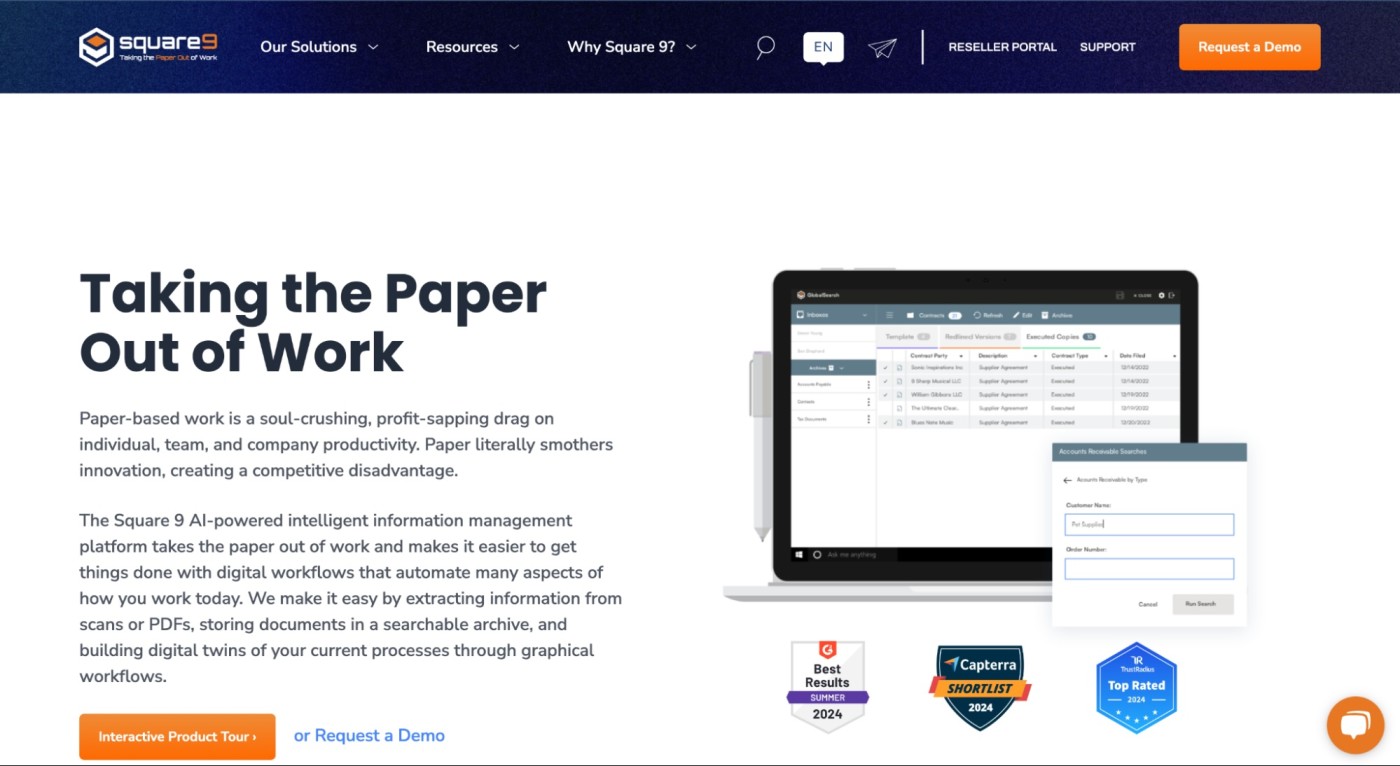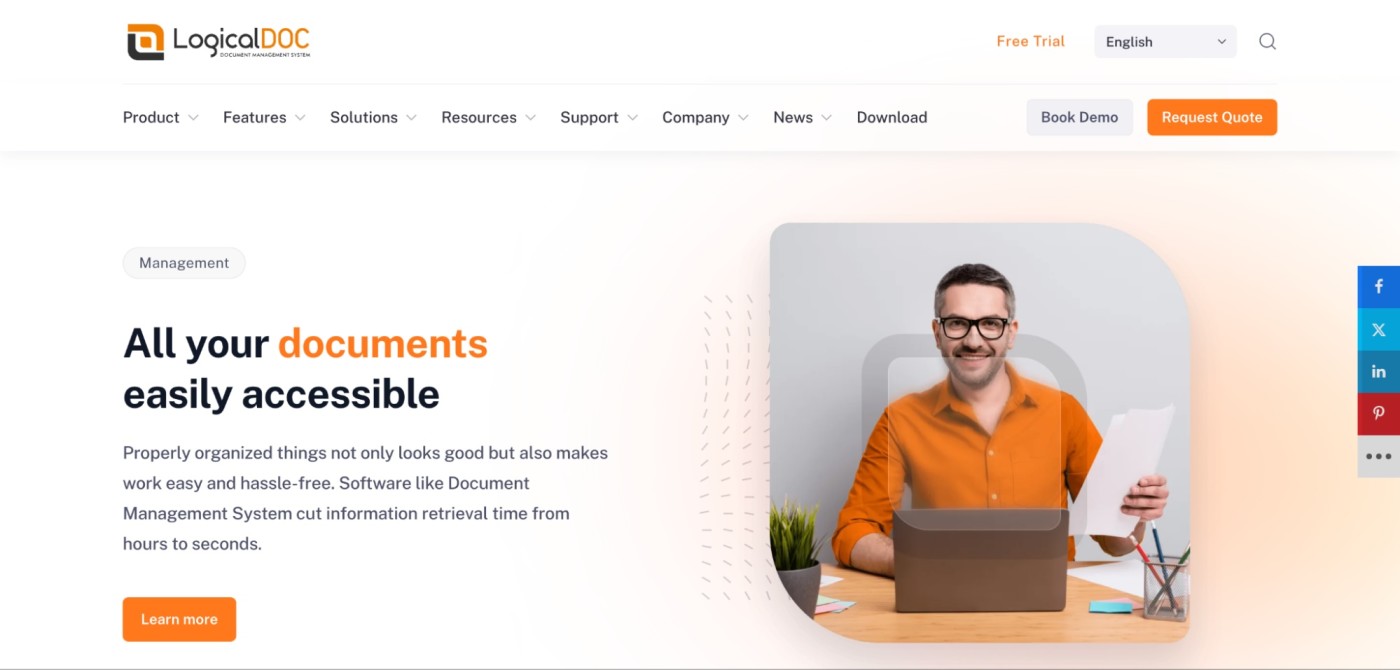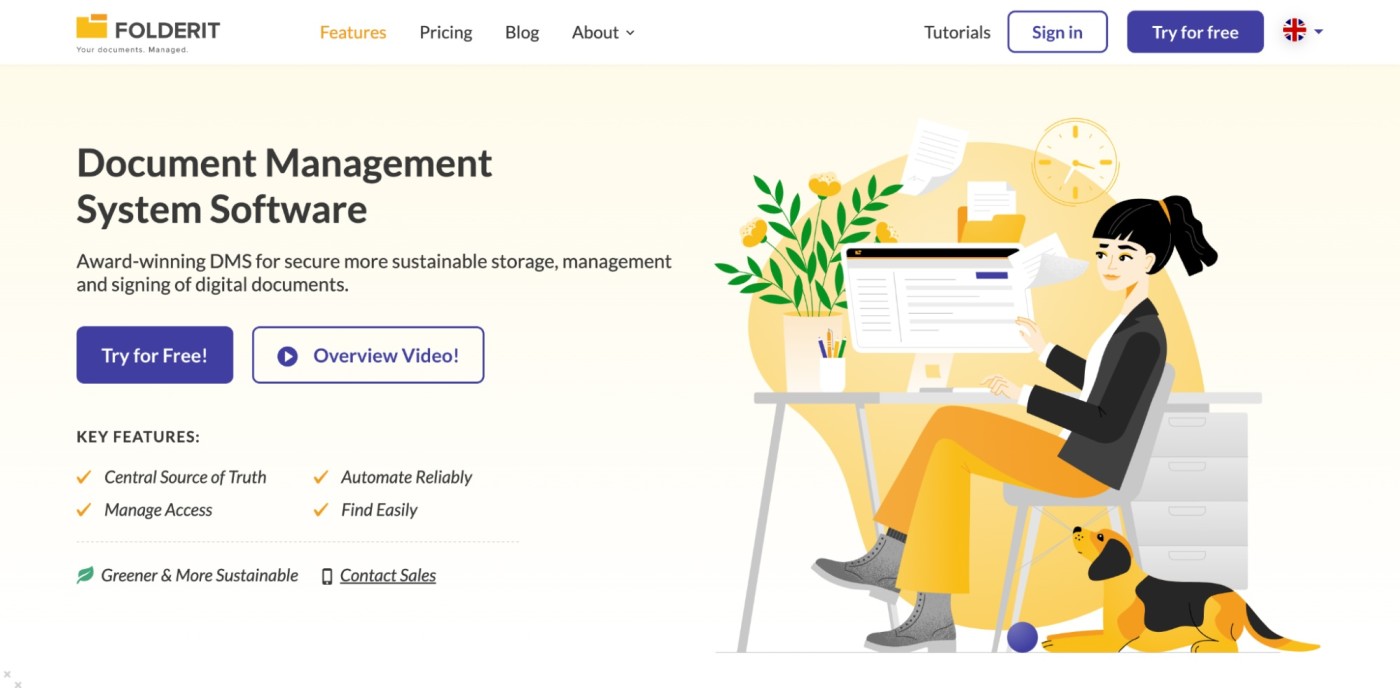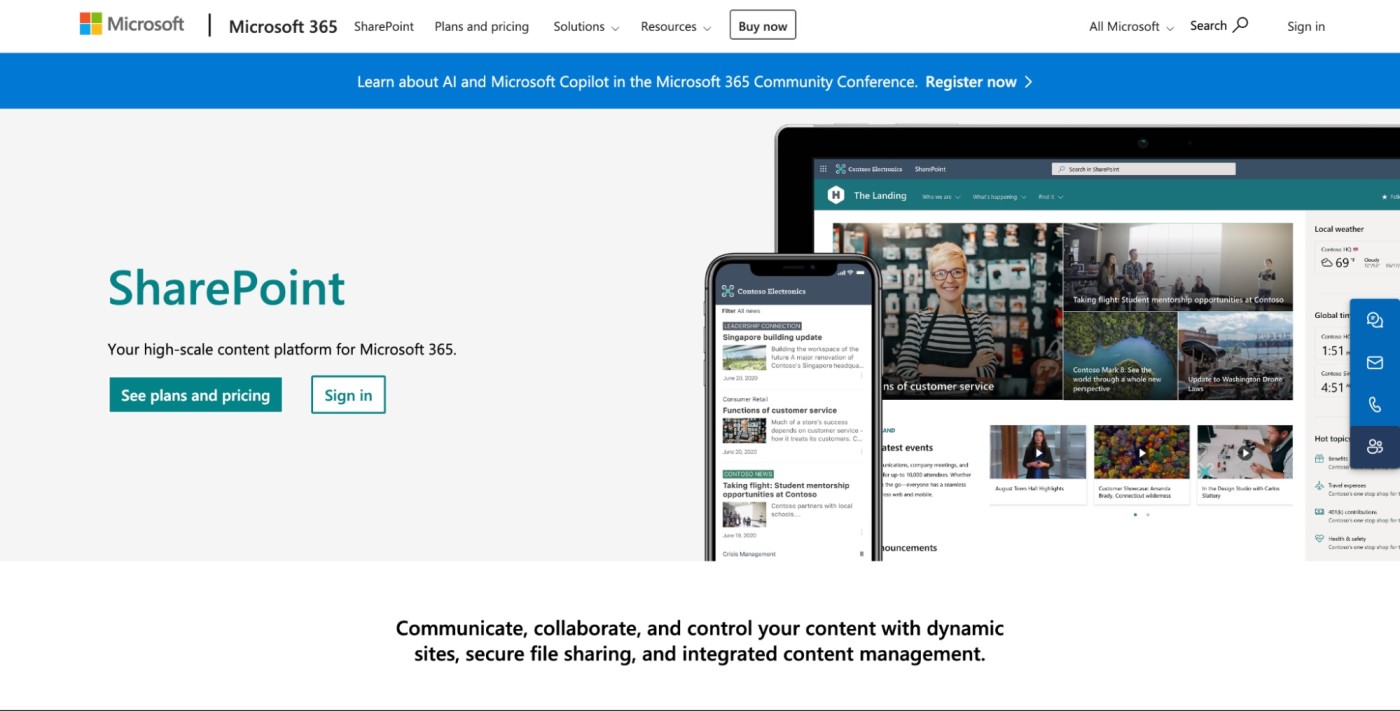


Apr 28, 2025
-
By Ivan
In today’s fast-paced digital environment, organizations are drowning in scattered documents, isolated data, and chaotic file systems. These inefficiencies aren't just frustrating—they’re costly. Enter AI-powered document management workflows: the game-changer reshaping how businesses handle documentation.
These intelligent systems aren’t just solving traditional bottlenecks—they're unlocking new levels of productivity, collaboration, and control.
Businesses across industries are rapidly adopting workflow and document management software to streamline processes and reduce overhead.
According to the IMARC Group, the global market for document management systems with workflow automation is expected to grow at a CAGR of 9.41% from 2025 to 2033, reaching a projected value of $19.2 billion. Similarly, Fortune Business Insights reports a growth rate of 16.6% between 2024 and 2032, with the market anticipated to hit $24.34 billion by 2032.
This surge highlights a clear trend: businesses are no longer viewing document management as a backend task—but as a strategic asset powered by AI and automation.
A document management workflow refers to the structured process of creating, reviewing, storing, and retrieving documents throughout an organization. An efficient workflow ensures:
Quick access to relevant documents
Controlled version history and permissions
Reduced duplication and errors
Smooth collaboration across departments
When powered by AI, this workflow becomes intelligent, adaptive, and proactive.
An effective document workflow is built on a set of core components that guide a document through its lifecycle—from creation to storage. These components ensure that every document is processed efficiently, securely, and collaboratively.

1. Document Creation
This is the initial stage where documents are generated. It can involve manual input (writing reports, drafting contracts) or automated generation using templates or AI tools. Ensuring consistency in formatting and structure at this stage sets the foundation for a smooth workflow.
2. Document Review & Collaboration
Once created, documents typically undergo one or more rounds of review. This involves sharing the document with relevant stakeholders, collecting feedback, and making revisions. AI tools can streamline this process by enabling real-time collaboration, tracking changes, and even suggesting edits.
3. Approval Process
After review, documents often require formal approval from managers, legal teams, or other departments. A well-defined approval workflow ensures accountability and compliance. With AI, you can automate notifications, track pending approvals, and enforce role-based permissions.
4. Version Control
As documents evolve, maintaining an accurate version history is crucial. This component tracks changes, logs who made them and when, and allows users to revert to earlier versions if needed. AI-enhanced systems can automatically detect key differences and highlight them for faster comparison.
5. Storage & Organization
Once finalized, documents need to be stored securely and organized in a logical, accessible manner. AI-driven tools can auto-tag and categorize documents based on content, context, or metadata, making them easier to retrieve later.
6. Search & Retrieval
A powerful search mechanism is essential for quickly finding the right document. Traditional keyword search is limited, but AI enables semantic and contextual search, allowing users to find documents using natural language queries.
7. Security & Access Control
Sensitive documents must be protected from unauthorized access. This component includes role-based permissions, encryption, audit trails, and secure sharing options. AI can also detect anomalies in access patterns, flagging potential security risks.
8. Archiving & Retention
Not all documents need to be stored indefinitely. An effective workflow includes policies for archiving outdated documents and retaining essential ones according to regulatory requirements. AI can automate retention schedules and alerts for expiring documents.
Designing a well-structured document management workflow is essential for ensuring consistency, boosting collaboration, and maintaining compliance. Whether you're starting from scratch or improving your current process, follow these six practical steps to build an efficient and scalable system using modern document management workflow :-

1. Identify Workflow Objectives
Start by defining what you want your document workflow to achieve. Are you aiming for faster approvals? Better version control? Improved compliance? Clear objectives help shape the structure and tools you’ll need.
2. Map the Document Lifecycle
Outline how documents flow through your organization, from creation to storage or disposal. Identify every touchpoint, including who creates, reviews, approves, accesses, and archives each document. This map becomes the foundation of your document management workflow.
3. Define Roles and Responsibilities
Assign specific roles to users involved in the workflow. For example, who initiates documents, who needs to review or approve them, and who has access at each stage? Most document management software allows for the setup of permissions, collaboration controls, and document visibility.
4. Choose the Right Document Management Software
Select a platform that supports AI-driven features to accelerate productivity. For example, you can now create any document using AI to generate structured content or technical content instantly based on prompts, eliminating the need to start from scratch. Look for other essentials like version history, approval routing, and secure sharing.
5. Automate Workflow Steps
Use your document management tool to automate repetitive tasks—like sending reminders, changing document status, or tagging users. Collaborative features like adding comments in docs ensure smooth communication between teams, speeding up the review and feedback loop.
6. Test, Train, and Optimize
Run a trial of your workflow with a small team. Observe any friction points and gather feedback. Train employees on new tools and best practices. Continue to monitor and optimize based on performance and evolving organizational needs.
Selecting the right workflow and document management software can dramatically improve your team's efficiency, collaboration, and document security. Here are five key factors to consider when making your choice:
1. Ease of Use and Adoption
The software should have an intuitive interface that your team can quickly adapt to. Complex setups can slow down your workflow rather than streamline it. Look for platforms that offer simple navigation, drag-and-drop document management, and easy onboarding features.
2. AI-Driven Capabilities
Modern document management software should do more than just store files. Choose a solution that offers AI-powered features like Create Doc using AI, Re-generate, compare, and optimize docs with AI, and smart search capabilities. These tools can significantly reduce manual work and speed up document workflows.
3. Collaboration Features
Effective collaboration is at the heart of a good workflow. Ensure the software allows you to Add Comments in Docs, Share Docs, embed media, chat within documents, and maintain version control. Real-time collaboration improves feedback loops and accelerates project timelines.
4. Integration and Scalability
Your document management software should seamlessly integrate with your existing tools—such as project management platforms, CRM systems, or cloud storage solutions. Additionally, it should scale with your organization's growth, supporting more users, projects, and advanced features like Move Documents Between Workspaces or Import Docs from Confluence.
5. Security and Compliance
Security is non-negotiable when managing sensitive documents. Look for features like role-based access control, audit trails, encryption, and automatic backup options. Strong security ensures your workflow remains compliant with industry regulations and internal policies.
With AI and automation revolutionizing business operations, choosing the right workflow and document management software is key to staying productive and organized. Below are 10 leading tools to consider in 2025—each offering unique features to streamline your document workflows and improve team collaboration.
Kroolo is more than just a project management tool—it's a comprehensive solution designed to streamline document workflows and ensure seamless collaboration.
As a workflow and document management software, Kroolo helps businesses centralize, organize, and automate their document creation, sharing, and management processes. Whether you are working on complex projects or simple day-to-day tasks, Kroolo empowers teams to enhance productivity and stay organized with ease.
Kroolo integrates seamlessly with over 25+ tools, making it one of the most versatile platforms for managing business workflows. Its robust capabilities simplify complex workflows, allowing teams to focus on what matters—achieving their goals.

Key Features of Kroolo for Workflow and Document Management:
Create and Manage Documents with AI
Kroolo simplifies document creation and management. With AI-powered tools, users can quickly generate, edit, and organize content, streamlining workflows. This feature ensures that documents are always up-to-date and easy to access, helping teams stay organized and efficient.
Advanced Formatting & Styling
Kroolo offers advanced formatting and styling tools to create visually appealing documents. Whether you're designing roadmaps, knowledge bases, or project plans, you can format documents with tables, images, links, and external files. This customization ensures that every document is tailored to your specific needs, supporting both content creation and presentation.
Collaborate with Chat in Docs
Reading lengthy documents can be time-consuming, but with Kroolo’s AI-powered chat functionality, you can interact with your documents in real-time. Ask specific questions, get quick responses, and navigate your documents effortlessly, saving valuable time and ensuring clarity in collaboration.
Compare & Optimize Documents
Kroolo takes document optimization to the next level with AI tools that automatically suggest ways to improve your content. You can compare versions, refine content, and make instant edits, all while enhancing the clarity and effectiveness of your documents.
Import and Export Docs
Kroolo makes it easy to import documents from tools like Confluence, streamlining collaboration across platforms. Additionally, exporting documents in formats like Markdown ensures that your work remains compatible and easily shareable with external teams or stakeholders.
Integrate Docs with Projects and Tasks
Kroolo enables seamless integration of documents into project tasks and workflows. You can add documents to specific tasks, projects, or sprints, ensuring that everyone involved has easy access to the resources they need. This centralized approach helps avoid the chaos of scattered documents and unorganized workflows.
Real-Time Collaboration with Comments
Kroolo allows users to leave inline and page comments, making collaboration efficient and straightforward. Whether you need to provide feedback or engage with teammates, Kroolo’s commenting features ensure communication stays organized and contextually relevant within the document itself.
Sub-Documents for Complex Projects
For larger projects, Kroolo lets you create sub-documents within main documents. This feature is ideal for breaking down complex information into manageable sections, keeping everything structured and easy to navigate.
Personalization of Documents
Kroolo allows you to personalize your documents with custom cover pages, avatars, and banners, giving your documents a professional touch. Personalizing your documents also helps keep your workspace organized and visually appealing.

via DocuWare
DocuWare stands out as a robust workflow and document management software, enabling businesses to automate and streamline critical processes across departments like HR, finance, and sales. Its visual workflow designer allows organizations to create tailored automation with minimal technical effort, boosting efficiency and reducing manual intervention.
Top Features:
Build custom workflows with a drag-and-drop editor for seamless automation of document-centric tasks.
Maintain complete control with transparency, audit trails, and role-based access for better compliance.
Mobile accessibility ensures users can handle document tasks on the go with timely alerts and escalations.

via Fluix
Fluix simplifies complex, paper-heavy processes by digitizing document workflows, making it easier for teams to collaborate, collect data, and complete tasks from anywhere. Designed for industries like construction, energy, and field services, Fluix boosts operational agility with real-time data access and workflow automation.
Top Features:
Centralize document control with built-in compliance tools and secure access management.
Enable smarter decisions by converting form data into strategic insights.
Streamline approval chains and routine tasks to minimize delays and eliminate bottlenecks.

via DocuSign
DocuSign revolutionizes how businesses handle agreements by automating the entire document lifecycle—from creation and collaboration to secure, legally compliant e-signatures. It’s widely adopted in legal, sales, and HR departments for accelerating contract management workflows.
Top Features:
Securely send and eSign documents from any device with globally recognized legal compliance.
Automate contract workflows through DocuSign CLM to reduce risk and improve consistency.
Leverage analytics to gain insights into agreement status and optimize performance.

via Avokaado
Avokaado is a modern contract lifecycle management (CLM) solution that helps organizations automate contract workflows and collaboration. With its no-code automation engine, Avokaado lets legal and business teams co-create, eSign, and manage contracts in a centralized workspace, reducing legal risk and improving speed.
Top Features:
Automate document creation and approvals using pre-set templates and clause libraries.
Collaborate with stakeholders in real time for smoother negotiations and faster sign-offs.
Use secure eSignatures to finalize contracts instantly from any device, anytime.

via Square 9
Square 9 streamlines document-driven processes with powerful workflow automation and intelligent data capture. Designed for businesses that handle high document volumes, it allows users to build customized workflows for document routing, retention, and secure disposal—without sacrificing compliance or efficiency.
Top Features:
Automate document lifecycles from capture to archival using GlobalAction workflows.
Extract and validate data with advanced OCR for faster processing at scale.
Securely manage documents across departments with intuitive search and permissions.

via LogicalDOC
LogicalDOC delivers a user-friendly document management experience built for fast adoption across teams. It mirrors a traditional filing cabinet, making it easier for employees to store, retrieve, and organize documents with minimal training, while offering powerful integrations and cross-platform compatibility.
Top Features:
Familiar folder structure and drag-and-drop tools speed up onboarding.
Access documents across multiple operating systems and devices.
Collaborate securely with version control and role-based permissions.

via Folderit
Folderit offers an ultra-simple, cloud-based document management system ideal for small teams and businesses. With advanced search capabilities, seamless file sharing, and offline access, Folderit ensures your documents are always within reach—no tech expertise required.
Top Features:
Intuitive, no-training-needed interface with quick setup.
Advanced search and tagging make document retrieval fast and precise.
Built-in integration with DocuSign and multiple sharing options.

via PandaDoc
PandaDoc combines document creation, management, and eSigning into a single streamlined platform. Tailored for small businesses, it comes with hundreds of pre-built templates and automation capabilities that accelerate proposal and contract workflows from start to finish.
Top Features:
Easily create documents with a robust template library and drag-and-drop editor.
Share files, request eSignatures, and track document status in real time.
Integrate with tools like Slack, Google Drive, and Zapier for workflow automation.

via Microsoft Share Point
Microsoft SharePoint is a scalable document management platform built for collaboration across departments and locations. With tight integration into the Microsoft ecosystem, it enables secure file sharing, version control, and automation for organizations managing diverse workflows.
Top Features:
Facilitate teamwork with document co-authoring and permission controls.
Track revisions with robust versioning and automated workflow tools.
Sync effortlessly with Microsoft 365 apps and external systems via Zapier.
Conclusion
Choosing the right document management software isn’t just about storing files—it’s about enhancing collaboration, boosting efficiency, and ensuring data security across your organization.
Whether you’re a small team looking for simplicity or a large enterprise needing robust automation and compliance tools, there’s a DMS tailored to your needs.
By aligning your choice with your specific workflows, user capabilities, and scalability requirements, you can transform document management from a daily burden into a streamlined advantage.
Ready to supercharge your productivity? Try Kroolo and experience AI-powered document and project management like never before. Sign up with Kroolo now!
Tags
Collaboration
Document Management